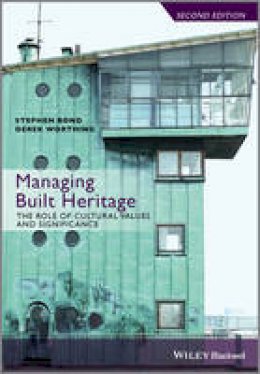
Stock image for illustration purposes only - book cover, edition or condition may vary.
Managing Built Heritage: The Role of Cultural Values and Significance
Stephen Bond
€ 81.91
FREE Delivery in Ireland
Description for Managing Built Heritage: The Role of Cultural Values and Significance
Paperback. This new edition examines management of built heritage through the use of values-led decision making, based on an understanding of the significance of the cultural asset. It considers how significance is assessed and used as an effective focus and driver for management strategies and processes. Num Pages: 272 pages. BIC Classification: AM; TNKX. Category: (P) Professional & Vocational. Dimension: 244 x 170. .
This new edition examines management of built heritage through the use of values-led decision making, based on an understanding of the significance of the cultural asset. It considers how significance is assessed and used as an effective focus and driver for management strategies and processes. The authors consider key policies and procedures that need to be implemented to help ensure effective management. The book will be useful for specialists in built heritage - conservation officers, heritage managers, architects, planners, engineers and surveyors - as well as for facilities and estates managers whose building stock includes protected or designated structures or buildings in conservation or other historic areas. * describes management strategies and tools for a wide range of built heritage assets * a reflective and informative guide on current conservation management * explains how understanding and using conservation values (significance ) is essential to the protection of the built heritage * uses real-life examples to draw out best practice
Product Details
Publisher
Wiley-Blackwell
Format
Paperback
Publication date
2016
Condition
New
Weight
547 g
Number of Pages
280
Place of Publication
New York, United States
ISBN
9781118298756
SKU
V9781118298756
Shipping Time
Usually ships in 15 to 20 working days
Ref
99-15
About Stephen Bond
Stephen Bond runs UK-based consultancy, Heritage Places, providing advice for the historic environment to national and local government, management and institutional clients, and charitable trusts. In the 1990s, he undertook a seven year secondment to Historic Royal Palaces, initially as its Surveyor of the Fabric, and subsequently as Director of the Tower Environs Scheme - a major regeneration scheme focused on the urban setting of the Tower of London. Today he works throughout the UK and on international projects, most recently providing heritage input into area-wide plans and capacity building programmes in Africa, Asia and Europe. He was involved with the Masters Programme in Conservation of the Historic Environment at the College of Estate Management for more than 20 years, lectures widely on heritage matters, and holds an honorary doctorate from De Montfort University. Derek Worthing has a professional background as an academic and a Chartered Building Surveyor. Until recently he was Head of the School of Land and Property Management at the University of the West of England where he was also co-director of the Centre for the Study of Sustainable Buildings in the Faculty of the Built Environment. He has carried out consultancy work in relation to the built cultural heritage for a number of national UK heritage organisations and has published research papers in relation to conservation plans and the maintenance and repair of listed buildings. He now works as a consultant and as a visiting professor at Uppsala University in Sweden where he has carried out research on the sustainable management of built cultural heritage as well as work on conservation plans for the Swedish Heritage Board.
Reviews for Managing Built Heritage: The Role of Cultural Values and Significance
'Worthing and Bond have achieved their aim of a practical guide to the policies and practices surrounding managing the built heritage based on an open and useful framework. The book should be of interest to those working in the field, offering well considered practical measures, grounded in recent critical thinking.'
Raymond Lucas, Construction History Society News
Raymond Lucas, Construction History Society News
